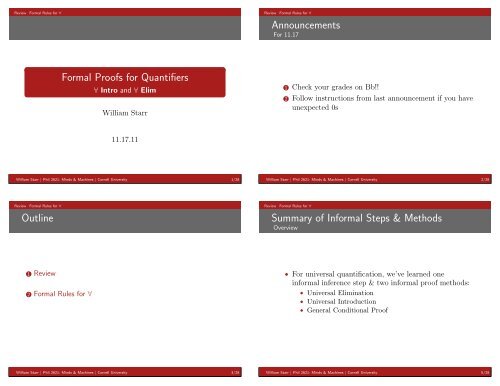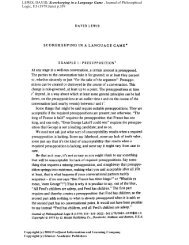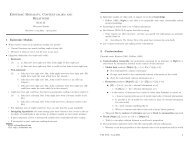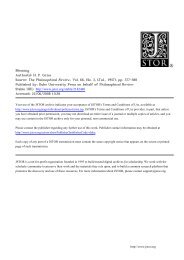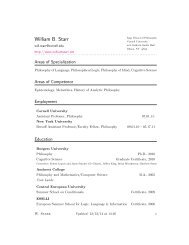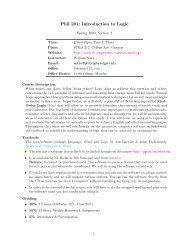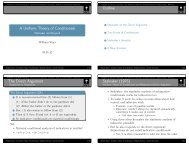Formal Proofs for Quantifiers - Will Starr
Formal Proofs for Quantifiers - Will Starr
Formal Proofs for Quantifiers - Will Starr
You also want an ePaper? Increase the reach of your titles
YUMPU automatically turns print PDFs into web optimized ePapers that Google loves.
Review <strong>Formal</strong> Rules <strong>for</strong> ∀<br />
Review<br />
<strong>Formal</strong> Rules <strong>for</strong> ∀<br />
Announcements<br />
For 11.17<br />
<strong>Formal</strong> <strong>Proofs</strong> <strong>for</strong> <strong>Quantifiers</strong><br />
∀ Intro and ∀ Elim<br />
<strong>Will</strong>iam <strong>Starr</strong><br />
1 Check your grades on Bb!!<br />
2 Follow instructions from last announcement if you have<br />
unexpected 0s<br />
11.17.11<br />
<strong>Will</strong>iam <strong>Starr</strong> | Phil 2621: Minds & Machines | Cornell University 1/28<br />
<strong>Will</strong>iam <strong>Starr</strong> | Phil 2621: Minds & Machines | Cornell University 2/28<br />
Review <strong>Formal</strong> Rules <strong>for</strong> ∀<br />
Outline<br />
Review<br />
<strong>Formal</strong> Rules <strong>for</strong> ∀<br />
Summary of In<strong>for</strong>mal Steps & Methods<br />
Overview<br />
1 Review<br />
2 <strong>Formal</strong> Rules <strong>for</strong> ∀<br />
• For universal quantification, we’ve learned one<br />
in<strong>for</strong>mal inference step & two in<strong>for</strong>mal proof methods:<br />
• Universal Elimination<br />
• Universal Introduction<br />
• General Conditional Proof<br />
<strong>Will</strong>iam <strong>Starr</strong> | Phil 2621: Minds & Machines | Cornell University 3/28<br />
<strong>Will</strong>iam <strong>Starr</strong> | Phil 2621: Minds & Machines | Cornell University 5/28
Review<br />
<strong>Formal</strong> Rules <strong>for</strong> ∀<br />
Summary of In<strong>for</strong>mal Steps & Methods<br />
Review<br />
<strong>Formal</strong> Rules <strong>for</strong> ∀<br />
An Example<br />
Using Universal Elimination & Introduction<br />
Universal Elimination (Official Version)<br />
If you have ∀x S(x), you may infer S(c), provided that ‘c’<br />
refers to an object in the domain of discourse<br />
Universal Introduction<br />
To prove ∀x S(x):<br />
1 Introduce a new name c to stand <strong>for</strong> a completely<br />
arbitrary member of the domain of discourse<br />
2 Prove S(c)<br />
3 Conclude ∀x S(x)<br />
1 ∀x Tet(x)<br />
2 ∀x (Tet(x) ∨ Small(x))<br />
Proof: We will use universal introduction to prove the<br />
conclusion. Let c name an arbitrary block. From 1 Tet(c)<br />
follows by universal elimination. But if that is true, so is<br />
Tet(c) ∨ Small(c) (by disjunction introduction). Since c was<br />
arbitrary, it follows that ∀x (Tet(x) ∨ Small(x)).<br />
<strong>Will</strong>iam <strong>Starr</strong> | Phil 2621: Minds & Machines | Cornell University 6/28<br />
<strong>Will</strong>iam <strong>Starr</strong> | Phil 2621: Minds & Machines | Cornell University 7/28<br />
Review<br />
<strong>Formal</strong> Rules <strong>for</strong> ∀<br />
Summary of In<strong>for</strong>mal Steps & Methods<br />
General Conditional Proof<br />
Review<br />
<strong>Formal</strong> Rules <strong>for</strong> ∀<br />
An Example<br />
General Conditional Proof<br />
General Conditional Proof<br />
To prove ∀x (A(x) → B(x)):<br />
1 Introduce a new arbitrary name c, and assume A(c)<br />
2 Prove B(c)<br />
3 Conclude ∀x (A(x) → B(x))<br />
• This is equivalent to using universal introduction and<br />
conditional proof together<br />
1 Medium(a)<br />
2 ∀y (Smaller(a, y) → Large(y))<br />
Proof: We will use general conditional proof to show our<br />
conclusion. Let c stand <strong>for</strong> an arbitrary block and assume<br />
<strong>for</strong> the sake of argument that Smaller(a, c). We will try to<br />
show that Large(c). From 1 we know that a is medium. But<br />
our assumption tells us that a is smaller than c, so c must<br />
be large. This is exactly what we were out to show to finish<br />
our general conditional proof, so we are done.<br />
<strong>Will</strong>iam <strong>Starr</strong> | Phil 2621: Minds & Machines | Cornell University 8/28<br />
<strong>Will</strong>iam <strong>Starr</strong> | Phil 2621: Minds & Machines | Cornell University 9/28
Review<br />
<strong>Formal</strong> Rules <strong>for</strong> ∀<br />
<strong>Formal</strong> <strong>Proofs</strong><br />
Getting Back Into the Swing of It<br />
• Remember <strong>for</strong>mal proofs?<br />
• Contains only wffs of fol<br />
• Every non-premise or assumption line must cite a<br />
<strong>for</strong>mal rule as its justification<br />
• Example:<br />
1 Tet(a) → Smaller(a, c)<br />
2 Tet(a)<br />
3 Smaller(a, c) → Elim: 2, 1<br />
4 Smaller(a, c) ∨ LeftOf(a, b) ∨ Intro: 3<br />
5 Tet(a) → (Smaller(a, c) ∨ LeftOf(a, b)) → Intro: 2-4<br />
Review<br />
<strong>Formal</strong> Rules <strong>for</strong> ∀<br />
<strong>Formal</strong> <strong>Proofs</strong><br />
Review<br />
• Remember: every logical symbol gets two rules:<br />
1 = Elim, = Intro<br />
2 ¬ Elim, ¬ Intro<br />
3 ⊥ Elim, ⊥ Intro<br />
4 ∧ Elim, ∧ Intro<br />
5 ∨ Elim, ∨ Intro<br />
6 → Elim, → Intro<br />
7 ↔ Elim, ↔ Intro<br />
• Recall that each of these rules was the <strong>for</strong>mal analog of<br />
an in<strong>for</strong>mal inference step or proof method<br />
• The rules are justified by the meaning of each symbol<br />
• Now, we’ll learn the <strong>for</strong>mal rules <strong>for</strong> ∀:<br />
∀ Intro, ∀ Elim<br />
<strong>Will</strong>iam <strong>Starr</strong> | Phil 2621: Minds & Machines | Cornell University 11/28<br />
<strong>Will</strong>iam <strong>Starr</strong> | Phil 2621: Minds & Machines | Cornell University 12/28<br />
Review<br />
<strong>Formal</strong> Rules <strong>for</strong> ∀<br />
∀ Elim<br />
Universal Elimination<br />
Review<br />
<strong>Formal</strong> Rules <strong>for</strong> ∀<br />
∀ Intro<br />
A Preliminary Note<br />
Universal Elimination (Official Version, In<strong>for</strong>mal Step)<br />
If you have ∀x S(x), you may infer S(c), provided that ‘c’<br />
refers to an object in the domain of discourse<br />
∀ Elim<br />
✄<br />
∀x S(x)<br />
.<br />
S(c)<br />
Example:<br />
1 ∀x (Tet(x) ∧ Small(x))<br />
2 Tet(c) ∧ Small(c) ∀ Elim: 1<br />
• Two methods of in<strong>for</strong>mally proving universal claims:<br />
1 Universal Introduction<br />
2 General Conditional Proof<br />
• We will consider two versions of ∀ Intro corresponding<br />
to each of these methods<br />
<strong>Will</strong>iam <strong>Starr</strong> | Phil 2621: Minds & Machines | Cornell University 15/28<br />
<strong>Will</strong>iam <strong>Starr</strong> | Phil 2621: Minds & Machines | Cornell University 17/28
Review<br />
<strong>Formal</strong> Rules <strong>for</strong> ∀<br />
∀ Intro<br />
Version 1<br />
Review<br />
<strong>Formal</strong> Rules <strong>for</strong> ∀<br />
∀ Intro, Version 1<br />
An Example<br />
∀ Intro Version 1 (<strong>Formal</strong> Method of Proof)<br />
✄<br />
.<br />
c<br />
P(c)<br />
∀x P(x)<br />
c must not occur outside of the<br />
subproof where it is introduced<br />
That is, c must be arbitrary<br />
• Read the boxed ‘c’ as let c<br />
be an arbitary member of<br />
the domain of discourse<br />
1 ∀x (Tet(x) ∧ Small(x))<br />
2 c<br />
3 Tet(c) ∧ Small(c) ∀ Elim: 1<br />
4 Tet(c) ∧ Elim: 3<br />
5 ∀x Tet(x) ∀ Intro: 2-4<br />
<strong>Will</strong>iam <strong>Starr</strong> | Phil 2621: Minds & Machines | Cornell University 18/28<br />
<strong>Will</strong>iam <strong>Starr</strong> | Phil 2621: Minds & Machines | Cornell University 19/28<br />
Review<br />
<strong>Formal</strong> Rules <strong>for</strong> ∀<br />
∀ Intro, Version 1<br />
Another Example<br />
Review<br />
<strong>Formal</strong> Rules <strong>for</strong> ∀<br />
∀ Intro, Version 1<br />
Using Fitch<br />
1 ∀x Tet(x)<br />
2 ∀x (Tet(x) ∨ Small(x))<br />
Proof: We will use universal introduction to prove the conclusion. Let c name an<br />
arbitrary block. From 1 Tet(c) follows by universal elimination. But if that is true,<br />
so is Tet(c) ∨ Small(c) (by disjunction introduction). Since c was arbitrary, it<br />
follows that ∀x (Tet(x) ∨ Small(x)).<br />
1 ∀x Tet(x)<br />
2 c<br />
3 Tet(c) ∀ Elim: 1<br />
4 Tet(c) ∨ Small(c) ∨ Intro: 3<br />
5 ∀x (Tet(x) ∨ Small(x)) ∀ Intro: 2-4<br />
<strong>Will</strong>iam <strong>Starr</strong> | Phil 2621: Minds & Machines | Cornell University 20/28<br />
• Let’s do Exercise 13.2<br />
• But, we’ll learn how to use Fitch to do it<br />
13.2 ∀x (Cube(x) ↔ Small(x))<br />
∀x Cube(x)<br />
∀x Small(x)<br />
<strong>Will</strong>iam <strong>Starr</strong> | Phil 2621: Minds & Machines | Cornell University 21/28
Review<br />
<strong>Formal</strong> Rules <strong>for</strong> ∀<br />
∀ Intro<br />
In Class Exercise<br />
Give a <strong>for</strong>mal proof that the following argument is valid<br />
∀y Small(y)<br />
∀x Cube(x)<br />
∀x (Cube(x) ∧ Small(x))<br />
It may be helpful to first do an in<strong>for</strong>mal proof<br />
Hint: Since you are trying to prove a universal claim, use<br />
the method of ∀ Intro<br />
Review<br />
<strong>Formal</strong> Rules <strong>for</strong> ∀<br />
∀ Intro<br />
The Rule, Version 2<br />
General Conditional Proof (In<strong>for</strong>mal Method of Proof)<br />
1 Introduce a new name c to stand <strong>for</strong> a completely arbitrary<br />
member of the domain of discourse and assume A(c)<br />
2 Prove B(c)<br />
3 Conclude ∀x (A(x) → B(x))<br />
∀ Intro Version 2 (<strong>Formal</strong> Method of Proof)<br />
✄<br />
.<br />
c A(c)<br />
B(c)<br />
∀x (A(x) → B(x))<br />
c must not occur outside of the<br />
subproof where it is introduced<br />
That is, c must be arbitrary<br />
• Read the boxed ‘c’ as let c be an<br />
arbitary member of the domain of<br />
discourse<br />
<strong>Will</strong>iam <strong>Starr</strong> | Phil 2621: Minds & Machines | Cornell University 22/28<br />
<strong>Will</strong>iam <strong>Starr</strong> | Phil 2621: Minds & Machines | Cornell University 24/28<br />
Review<br />
<strong>Formal</strong> Rules <strong>for</strong> ∀<br />
∀ Intro<br />
General Conditional Proof<br />
Review<br />
<strong>Formal</strong> Rules <strong>for</strong> ∀<br />
∀ Intro<br />
An Example<br />
1 Medium(a)<br />
2 ∀y (Smaller(a, y) → Large(y))<br />
Proof: Let c be an arbitrary block & assume Smaller(a, c). Since our<br />
premise says that a is medium, our assumption requires that Large(c).<br />
Because c was arbitrary, the conclusion follows by General<br />
Conditional Proof.<br />
1 Medium(a)<br />
2 c Smaller(a, c)<br />
3 Large(c) Ana Con: 1,2<br />
4 ∀y (Smaller(a, y) → Large(y)) ∀ Intro: 2-3<br />
<strong>Will</strong>iam <strong>Starr</strong> | Phil 2621: Minds & Machines | Cornell University 25/28<br />
1 ∀x [Tet(x) → ¬Cube(x)]<br />
2 ∀x [¬Cube(x) → Small(x)]<br />
3 c Tet(c)<br />
4 Tet(c) → ¬Cube(c) ∀ Elim: 1<br />
5 ¬Cube(c) → Elim: 3,4<br />
6 ¬Cube(c) → Small(c) ∀ Elim: 2<br />
7 Small(c) → Elim: 5,6<br />
8 ∀x [Tet(x) → Small(x)] ∀ Intro: 3-7<br />
Hint: working backwards is very helpful w/∀ Intro<br />
<strong>Will</strong>iam <strong>Starr</strong> | Phil 2621: Minds & Machines | Cornell University 26/28
Review<br />
<strong>Formal</strong> Rules <strong>for</strong> ∀<br />
Another Example<br />
In Fitch<br />
Review<br />
<strong>Formal</strong> Rules <strong>for</strong> ∀<br />
Summary<br />
For 11.17<br />
Time permitting, in Fitch:<br />
1 Exercise 13.7<br />
Summary<br />
1 We learned how to use ∀ Elim and ∀ Intro<br />
• ∀ Intro came in two versions corresponding to our<br />
two in<strong>for</strong>mal proof methods<br />
• Both versions used the notation of boxing constants<br />
where our in<strong>for</strong>mal proofs used ‘arbitrary names’<br />
2 When using ∀ Intro it is very helpful to work<br />
backwards<br />
<strong>Will</strong>iam <strong>Starr</strong> | Phil 2621: Minds & Machines | Cornell University 27/28<br />
<strong>Will</strong>iam <strong>Starr</strong> | Phil 2621: Minds & Machines | Cornell University 28/28


